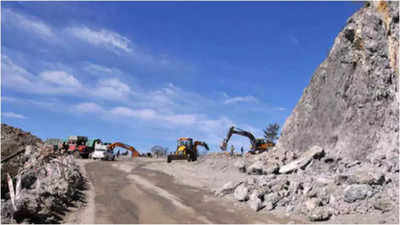- News
- India News
- SC cites national security, allows Char Dham project
Trending
This story is from December 15, 2021
SC cites national security, allows Char Dham project
The Supreme Court on Tuesday allowed widening of major portions of the strategic Char Dham road project in Uttarakhand to enable speedy deployment of men, machinery and armament by the armed forces on the India-China borders, given the recent Chinese build-up, but struck a delicate balance on green concerns by ordering strict implementation of environment protection measures.
NEW DELHI: The Supreme Court on Tuesday allowed widening of major portions of the strategic Char Dham road project in Uttarakhand to enable speedy deployment of men, machinery and armament by the armed forces on the India-China borders, given the recent Chinese build-up, but struck a delicate balance on green concerns by ordering strict implementation of environment protection measures.
Except for the road leading from Rishikesh to Yamunotri, which the ministry of defence (MoD) had not sought permission to widen, a bench of Justices DY Chandrachud, Surya Kant and Vikram Nath gave MoD and ministry of road transport and highways (MoRTH) permission for double lane paved shoulder (DLPS) highways linking Rishikesh to Mana (beyond Badrinath), Rishikesh to Gangotri and Tanakpur to Pithoragarh. This will provide an additional two-metre width to strategic roads for easy and rapid transportation of men and defence equipment.
In doing so, the bench modified the court’s September 8, 2020 order, passed by a bench headed by Justice RF Nariman, declining permission to widen the strategic roads as per the requirement of the armed forces. While the SC’s 2020 order was based on MoRTH notification of 2018, Tuesday’s judgment allowed double-lane carriageway with paved shoulders as provided in the 2020 MoRTH circular. The extra width is typically marked at the sides of the carriageways.
Writing the 83-page judgment that weighed the national security concerns and requirement of armed forces and the indisputable need to protect the environment, Justice Chandrachud said the SC-constituted high-powered committee’s (HPC) recommendations for preservation of environment and remedial measures in carrying out the Chardham project must be implemented in letter and spirit. This is aimed at preserving transfer of inter-generational environmental capital.
Justices Chandrachud, Kant and Nath unanimously felt that the national highways provide vital connections to the establishments of the armed forces along the Nelong Axis, Mana Pass, Rimkhim Pass, Niti Pass and Lipulekh Pass (all of it along the Indo-China border). “We find that the need for the development of national highways of a DLPS standard is proportionate to the object of fulfilling the security concerns of the nation
as assessed by the MoD. This is reinforced by the fact that the roads beyond the highways in the project, beyond Gangotri, Mana and Pithoragarh are being developed by the MoD as double-laned highways,” the bench said. The previously appointed high powered committee on the project could not have evaluated the security aspect, they held.
The three-judge bench set up an oversight committee headed by former SC judge A K Sikri, and comprising a representative each from National Environment Engineering Research Institute (NEERI and Forest Research Institute, to ensure implementation of the HPC-recommended environment protection measures for Chardham project.
However, the Justice Chanrachud-led bench clarified that the objective of the committee is “not to undertake an environmental analysis of the project afresh but to assess the implementation of the recommendations already provided by the HPC”. The SC directed all authorities concerned, including MoD and MoRTH, to place a monthly report on compliance of environmental safeguards before the committee, which in turn will file a report before the SC every four months.
It said the HPC “shall continue with its work on overseeing the implementation of its recommendations for the project, except for the national highways from Rishikesh to Mana, Rishikesh to Gangotri, and Tanakpur to Pithoragarh, which shall now fall under the purview of the Oversight Committee”.
The bench said a statement made to the media by then Army chief Bipan Rawat that existing roads were good enough for the needs of the Army cannot be cited as a ground to deny widening of roads. “The appellants (NGO Citizens for Green Doon) have referred to a statement made...in 2019 in a media interview... The recent past has thrown up serious challenges to national security. The Armed Forces cannot be held down to a statement made during a media interaction in 2019 as if it were a decree written in stone.... This Court, in its exercise of judicial review, cannot second-guess the infrastructural needs of the Armed Forces... The submission of the appellants requires the Court to interrogate the policy choice of the establishment which is entrusted by law with the defence of the nation. This is impermissible.”
A controversy had emerged with the HPC report on the Char Dham project. While the overwhelming majority approved the project, the chairman of the HPC had authored a dissent note citing environmental catastrophe that could be triggered by the project on a young mountain range like the Himalayas. Justice Chandrachud said the HPC may be competent to assess the environmental impact of the project on Himalayas but was certainly not qualified to assess the security needs of the country, given the recent developments on the northern borders due to amassing of troops and positioning of armaments by China.
“The competing interests that the HPC had to evaluate were environmental concerns as against infrastructural development, the primary reason of which in this project was focused on increasing tourism, providing an impetus to the economy, and ease of transportation for undertaking the Char Dham pilgrimage. Balancing the interests of defence as against environmental considerations was outside the ambit of the HPC,” the bench said.
Extracting the environmental concerns and mitigation measures suggested by HPC for Char Dham project, the bench said, “We direct that the MoRTH and MoD can proceed with the project subject to the condition that it addresses all the concerns which have been raised by the HPC and enumerated by this court in this judgment...”
“The considerations for development of national highways in plains and in hilly and mountainous regions are not identical. Similarly, the considerations governing the construction of highways that are strategic roads from a defence perspective, and may be used by the armed forces of the nation, cannot be the same as those for other roads in hilly and mountainous regions. We must therefore arrive at a delicate balance of environmental considerations such that they do not impede infrastructural development, specifically in areas of strategic importance crucial to the security of the nation,” it said.
Stay updated with the latest news on Times of India. Don't miss daily games like Crossword, Sudoku, and Mini Crossword.
End of Article
FOLLOW US ON SOCIAL MEDIA
Visual Stories
Hot Picks
TOP TRENDING
Explore Every Corner
Across The Globe











